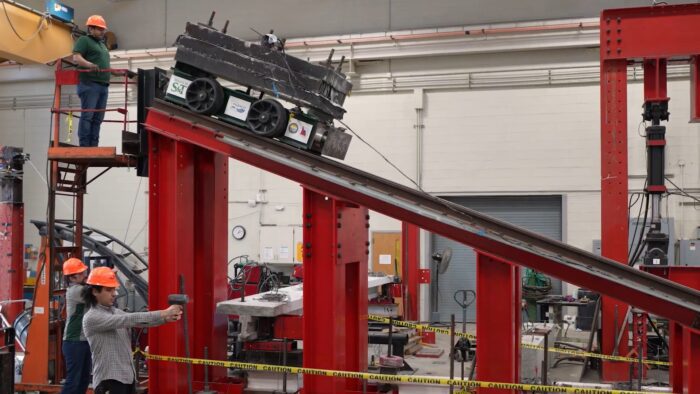Crash course: Missouri S&T researchers bridge the gap with collision study

S&T researchers watch with anticipation as the 7,000-lb cart heads toward the bridge girder. Photo by Terry Barner/Missouri S&T.
ROLLA, Mo. – What do Missouri University of Science and Technology researchers do when they want to study the impact of tractor-trailers colliding into bridges?
They bring the collisions to the university’s campus with a massive setup that, at first glance, looks like a red roller coaster.
Over the past few years, a team of researchers led by Dr. Mohamed ElGawady, a professor of civil engineering and Kaplan Faculty Scholar at S&T, has constructed a railway system that is 60 feet long and 12 feet tall and transports a 7,000-lb cart that crashes into a full-size, 46-foot-long bridge girder. The project takes up a large amount of floor space in the university’s Structural Engineering Research Laboratory.
“This is a unique project that will allow our researchers to obtain a wealth of data related to bridge collisions,” ElGawady says. “Where else can students and researchers work on anything like this? We are conducting cutting-edge research and giving our students some exceptional learning experiences.”
S&T researchers are in the process of conducting 14 crashes into bridge girders with different designs. They will assess the damage caused by the crashes, consider and test different repair methods, and use computational simulations to determine the life expectancy of bridges after collisions.
This will help with bridge safety and maintenance, which could also lead to cost savings for the bridges as well, ElGawady says.
“Every time one of these crashes happens — and they happen far too often across the United States — bridges may lose a certain amount of their integrity when they are repaired,” he says. “We are conducting this research to help avoid such losses and infrastructure delays.”
The S&T team put the entire railway system together piece by piece, with many of the materials being donated by Nucor Corp.
“We fabricated everything in-house,” ElGawady says. “This isn’t an off-the-shelf type of roller coaster setup you can purchase for an amusement park. It took about two years of computer simulation and design.”
However, the university does have a part of a true roller coaster track as well, which Dr. Mohanan Abdulazeez, an S&T post-doctoral fellow working with ElGawady, says the team used for considering and rehearsing how everything may work on the larger-scale setup.
Abdulazeez says the research team, which also includes collaborators from the University of Idaho, plans to have the study completed in about two years. Those findings will be shared with a large group of partners who have contributed to the $800,000-plus pooled fund used for the project.
The Missouri Department of Transportation (MoDOT) serves as the pooled fund administrator, and other states involved include Texas, Ohio, Mississippi, Idaho and Alaska. The Federal Highway Administration and Mid-American Transportation Center are providing support as well.
“It will be exciting to share our results and hopefully make a difference across the country,” Abdulazeez says. “We are collecting valuable data and running advanced computational models that should make a significant difference when considering future bridge collisions and repairs.”
About Missouri S&T
Missouri University of Science and Technology (Missouri S&T) is a STEM-focused research university of over 7,000 students located in Rolla, Missouri. Part of the four-campus University of Missouri System, Missouri S&T offers over 100 degrees in 40 areas of study and is among the nation’s top public universities for salary impact, according to the Wall Street Journal. For more information about Missouri S&T, visit www.mst.edu.
Featured video: https://www.youtube.com/watch?v=m2qNaRQi4HM&t=2s


